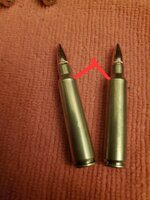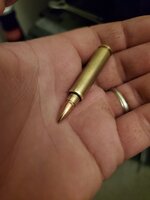Silver Supporter
Bronze Lifetime
- Messages
- 2,036
- Reactions
- 5,736
- Thread Starter
- #141
So if I'm loading to SAAMI specs, I don't need to worry about the jam/jump, they should chamber properly in any rifle right? I don't have any custom specifications for any rifles I'm shooting, so there's no custom rifling or anything. Is there a benefit to jamming to the lands, or is that the no-no I'm trying to avoid?It's basicly a gauge that tells you whether or not the case is resized correctly. Some gauges measures head space but typically as long as the shoulder is correct and the case is the correct length, your good to go.
I use one and it works really well, there are ones you can use for after you load but I just use my mags and barrel, if it doesn't fit those, it fails. I load to my 5.56 and 7.62x51 to SAMMI spec and use a factory crimp die so I don't have to worry if the neck is a little shorter or if the bullet will come loose.













